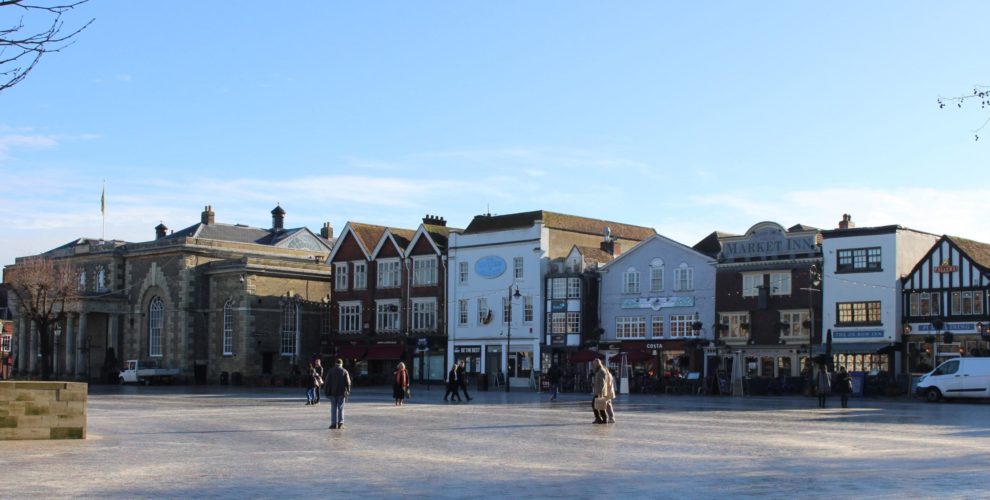What comes to mind when you think of the city of Salisbury?
For those of you from outside the UK, it would be understandable if your answer were ‘nothing’.
British people might recall the 2018 Novichok scandal. After all, the poisoning of the ex-Russian spy and his daughter in this sleepy English town made headline news for months.
Others may know it as the city near the place with the funny rocks (Stonehenge).
Whatever your associations, it is unlikely that you see it as a beautiful and magical tourist destination in and of itself.
However, as I discovered on one cold, crisp January day, Salisbury is not a town to be overlooked.
So come with me as we take a trip around this quaint English City, with its awe-inspiring cathedral, historic buildings and lush green gardens.
A Hint of the European
Our tour starts in the market square. What strikes me first is although Salisbury is known for being a quintessentially English village, this large, open space reminds me more of the splendid Piazza’s of Italy than your typical English village square.
I imagine that on Tuesday and Saturday, the town’s regular market days, the square bustles with life and noise. On this quiet, winter morning however, the square has a far more peaceful atmosphere. A few people sit on the stone benches scattered around the square, soaking in the golden January sun.
The buildings that line the square are exquisite monuments to the town’s rich history. The proudest of these buildings is without a doubt the Guildhall, a large stone building with floor to ceiling pillars. The Guildhall’s story dates back to medieval times. The current structure was built in the 18th century after the town’s council houses burnt down in a fire.
On the opposite diagonal of the square, a life-sized statue of Henry Fawcett stands on a polished granite plinth. Born in Salisbury in 1833, Fawcett led a fascinating life. Despite being blinded in a hunting accident when he was just 25, he went on to become a professor at Cambridge University and later the Postmaster General.
Henry Fawcett was also an ardent supporter of the women’s suffrage movement. Through his campaigning, he met Elizabeth Garret, who was to become the first female doctor in the UK. He proposed to her but she turned him down for fear that marriage would damage her career prospects. Two years later, he married her younger sister, Millicent Garret.
Where the Past Collides with the Present
We will leave the square now and slip through a narrow alleyway onto the paved street of Butcher’s Row. Your eyes will be drawn to the bizarre stone structure that is the poultry cross. This is the last remaining of Salisbury’s four market crosses; sadly the three other crosses, including the ‘cheese cross’, no longer stand.
As you look down the street, you can’t help but be struck at how the past fuses so seamlessly with the present. At first glance, you may see just your average high street with its generic chain stores but look a little closer and the whole street will transform before your eyes. Firstly, the traditional butchers with a little old-fashioned cart will make itself known. Then, if you allow your gaze to rise above the shopfronts, you will see that the buildings in which these modern shops are housed are beautiful examples of a bygone age.
As we walk now along the larger Bridge Street, we will see to our right the gorgeous 17th century Bishop’s Mill, which is now a riverside pub. Here we’ll cross the river Avon to reach the lovely clock tower, which looks like a scaled-down stone imitation of Big Ben. Once you’ve taken your photos, we can head back across the bridge and head along the path that winds along the river Avon.
We’ll come to the old stone Crane Bridge and once again cross the river. A few minutes further along the road and we’ll reach our next destination; the Queen Elizabeth Gardens. Created in the 1960s to celebrate Queen Elizabeth 1I’s coronation, these gardens are a lush oasis of calmness and tranquillity. With fields stretching out as far as the eye can see, these beautiful gardens feel much more natural than many of the more manicured city parks.
The Crown Jewel
Once you’ve had your fill of the beautiful views, we’ll retrace our steps back over Crane Bridge. From here, we’ll keep walking straight ahead until we reach the High Street, turn right and soon we’ll reach the High Street Gate. As you step through the grand stone gateway complete with its royal coat of arms, you should prepare yourself for a breath-taking sight.
A few steps on from the gateway Salisbury’s crowning Jewel, its truly majestic Cathedral, comes into view. The main body of this building was built in the 13th Century and incredibly took just 38 years to complete. The spire, which is the highest church spire in the UK, stretches to a dizzying 123 metres into the air.
Once you’ve recovered from this truly awe-inspiring sight, it would probably be a good time to mention that we don’t just have to view this building from afar. For just a small, voluntary donation, you are free to marvel at the Cathedral’s incredible interior, with its intricate colourful stained glass windows and beautiful, high ceilings.
Not to be missed is the Magna Carta, one of the most famous documents in the world. Inside the Chapter House, you can see the best preserved of the four remaining copies of this highly significant historical document. On this aged parchment are written a charter of rights that were agreed to by King John of England in 1215 and are seen by some to be the foundation of democracy.
If any of the sights of the day have sparked your interest in the history of this fascinating city, then I can’t recommend enough The Salisbury Museum. This friendly museum is located in the cathedral close, in a beautiful old building. It displays an impressive range of local history collections. If you have any questions, I do not doubt that the passionate staff will happily stop and chat with you about anything and everything that draws your interest.
Conclusion
As we come to the end of our tour, I hope you’ve enjoyed your time in this marvellous, magical city. Perhaps, like me, you’ll have the desire to shout about this city from the rooftops, or even the top of that 123-metre spire. I want others to experience walking through streets, in which history merges so completely with the present day. One thing that I’m sure off, is that on your way home from this wonderful city, you will already be planning your return.
Glossary
➛Scandal – behaviour or an event that people think is morally or legally wrong and causes public feelings of shock or anger
➛Association – an idea or a memory that is suggested by somebody/something; a mental connection between ideas
➛Quaint – attractive in an unusual or old-fashioned way
➛Quintessentially – in a way that represents the perfect example of something
➛Blind – not able to see
➛Postmaster General – a position in the government. This person would be responsible for the postal service of the country. The position no longer exists.
➛Suffrage – the right to vote in political elections
➛Market cross – a structure used to mark a market square in market towns.
➛Butcher’s – a shop that sells meat
➛Imitation – a copy of something, especially something expensive
➛Coronation – a ceremony at which a crown (= an object in the shape of a circle, usually made of gold and precious stones) is formally placed on the head of a new king or queen and they officially become king or queen
➛Cathedral – the main church of a district, under the care of a bishop (= a priest of high rank)
➛Spire – a tall pointed structure on the top of a building, especially a church
➛Donation – something that is given to a person or an organization such as a charity, in order to help them; the act of giving something in this way
➛Parchment – material made from the skin of a sheep or goat, used in the past for writing on












Leave a Reply